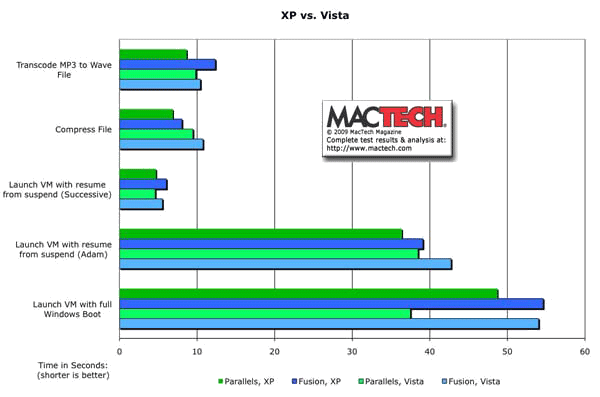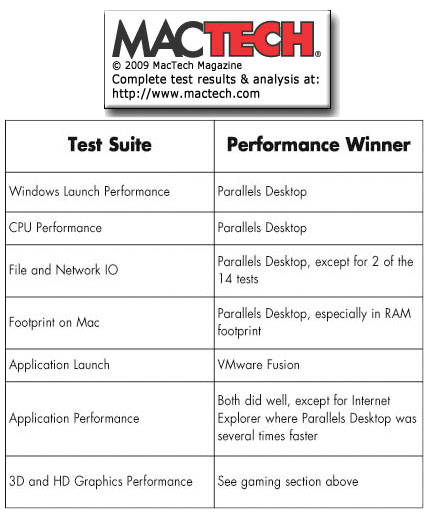MacTech Magazine ran both virtual machines through thousands of real-world tests, timed with a stopwatch, to find out which performs the fastest. The results are in a five-page story at its website, which AppleInsider highly recommends that prospective buyers of either solution read in full.
Acknowledging Apple's own Boot Camp, which can boot natively into Windows, MacTech decided to look only at virtual machines since they do not require restarting to switch between operating system environments. The publication was also interested in determining which operating system - Windows XP or Vista - offers the best performance. The testers kept an eye on the differences between larger memory configurations, multiple processors, and 64-bit versions of the OS.
To facilitate these tests, they used four different models of Macs to cover the range of machines actual customers would use with more than 2,500 total tests. Again, each was timed with a stopwatch for real-world results to avoid difficulties in running diagnostics on virtual machines that don't always properly keep track of the time it takes for tasks to execute.
Specific tests included: performance (launch and CPU), file and network IO, footprint, application launch and performance, and tests of 3D and HD graphics and games.
Parallels Desktop was the clear winner, running 14 to 20 percent faster than VMware Fusion in the majority of overall averages. There was only one exception when VMware was faster: 32-bit Windows XP on two virtual processors, which ran about 10 percent faster than Parallels.
Overall Test Results
Parallels
- 14% faster running 32-bit XP and Vista on a single virtual processor
- 20% faster running 32-bit Vista on two virtual processors
- 15% faster running 64-bit Vista on two virtual processors
VMware Fusion
- 10% fasster running 32-bit XP on two virtual processors
Launch and CPU Tests
In using Windows' compression tools and MP3 to WAV transcoding, Parallels was faster in every version of the test, ranging from 7% faster when launching virtual XP and resuming from suspend after a full restart, to 31% faster after a full Windows boot on Vista. Â The contest was closest when both Parallels and VMware Fusion were launched without restarting, allowing the benefits of caching. Â In that test, Parallels was 17 percent faster in Vista and 22 percent faster in XP, but the range was only zero to one second.
Application Launch Test (Word and Outlook)
Here, there was no clear advantage for either virtualization engine. Â When launching Microsoft Word after a full reboot, Fusion was faster by 8 percent on XP while Parallels trumped with Vista at a 33 percent faster clip. Â Without a restart, Fusion notched a sweep, while the two again split with launching Outlook (Fusion narrowly won with XP, Parallels with Vista).
Application Performance Tests
MacTech did a global search and replace of about 95,000 items in a very large Word document, and in Excel, they ran a macro to generate a large amount of random numbers, filling cells with them. Â PowerPoint rendered slides with transitions as quickly as possible.
In the Word test, Parallels was faster under both XP (4 percent) and Vista (9 percent), with similar results on Excel (14 percent faster on XP, 13 percent on Vista). Â However, Fusion did score a victory with XP on the PowerPoint test, albeit a small one, at two percent. Â On Vista, it was a tie.
Internet Explorer Speed Test
MacTech created a large, complex page in HTML served from a local LAN server using common HTML elements and no JavaScript. VMware Fusion took significantly longer across the board, so they removed the results from the overall analysis to avoid it skewing the results. In general, Parallels was more than 80% faster in XP and Vista both with and without SSL.
Footprint Tests
Three footprint tests were also run. The first booted Windows, let it finish, and then measured CPU while both Mac OS X and Windows were sitting idle. The second test was similiar but evaluated launches of Word and Outlook, and the third gauged CPU usage while playing a DVD. In all three tests, Parallels and Fusion fared well.
Virtual Machine Memory Usage
As part of its Virtual Machine Memory Usage tests, MacTech noticed that Parallels only took memory from Mac OS X when Windows needed it. The publication ran an "endless loop" macro in Excel that generated random numbers. When battery life approached the end, Parallels paused the virtual machine and the Mac went into hibernate, saving the state of the virtual machine. VMware Fusion suspends the virtual machine before sleeping. The end result was that Parallel's battery usage lasted at least 8 percent longer in both XP and Vista.
File and Network IO Tests
In a highly refined I/O test — due to problems discovered throughout the testing proccess — 3.7GB of data (two 1.85GB files) was duplicated and copied to and from a Mac hard drive, LAN Server, and USB Flash drive under both XP and Vista. Parallels beat out Fusion hands down in all but 2 of the 14 tests.
3D and HD Graphics Tests
XP: Smoothly played both 720p and 1080p videos in both environments.
Vista: Couldn't play 720p at all in Parallels. VMware Fusion stuttered on every machine except the Mac Pro. Given 720p results, MacTech didn't bother trying 1080p.
Games
MacTech found that frames per second was a poor indicator of quality, as VMware Fusion, despite running Civilization IV: Colonization at a lower frame rate, had better-looking graphics. Parallels ran Portal better, but the testers were impressed with overall game performance on both platforms.
Final Conclusions
The publication determined the performance differences between XP and Vista are small enough to where users can choose whichever OS they want; that is, the "Vista penalty" is gone. However, the testers did prefer XP's stability and "less annoying" behavior.
When it comes to multiple virtual processors and running in 64-bit, it was concluded that 64-bit wasn't helpful for anything but computationally intense applications like CAD, so most users won't need them. The ability to address more memory in 64-bit mode was similarly deemed irrelevant since many Windows applications and drivers aren't yet 64-bit compatible, and there are plenty of reports of problems in virtual machines trying to run them to recommend against it until technology improves.
Finally, MacTech concluded that XP with 1GB of RAM and one virtual processor will be more than adequate for the majority of users. In fact, more RAM meant longer virtual machine launch times, suspends, and resumes. The testers recommend using only as much memory as needed.
Parallels Desktop was the clear favorite for its small footprint (it only takes more RAM from OS X when needed) and performance advantages in every environment except one. MacTech, though, believes both are excellent products that can run Windows XP and Vista well, so it will be up to the user to decide based on whichever factors are most important in each individual case.
The full 5-page report includes a plethora of detailed test results and graphs. It's recommended for all prospective or current Mac virtualization users.
Purchasing Parallels and VMWare Fusion
Parallels 4 retails for $79.99 but can be purchased and shipped from Amazon for just $49.99 after an instant $10 savings and an additional $20 rebate. For those readers looking to purchase Parallels 4 and download it immediately, Parallels offers this option through its own website for $79.99. However, readers can get $10 off the digital download through this link. (Note that Parallels automatically adds a $6.99 "Extended Download" option to the shopping cart of all of its online orders, which can be removed easily by clicking the "X" to the far right.)
Fusion also retails for $79.99 but Amazon is offering 24% off VMWare Fusion 2.0 ($60.49), though readers interested in saving another $8 may elect to purchase 1.0 for $52.29 and upgrade to 2.0 at VMWare's website for free.
 Zach Spear
Zach Spear









-m.jpg)






 Charles Martin
Charles Martin

 Malcolm Owen
Malcolm Owen
 William Gallagher
William Gallagher

 Christine McKee
Christine McKee
 Wesley Hilliard
Wesley Hilliard









45 Comments
It's free and arguably better than VMWare and certainly better than Parallels for running just about any OS you can throw at it.
It's free and arguably better than VMWare and certainly better than Parallels for running just about any OS you can throw at it.
Yeah, why do these comparisons never mention VirtualBox? Come on AI, you should have taken MacTech to task over this. All I know is that VirtualBox exists and runs on OS X, it'd be nice if someone would include it in these head-to-heads to shed light on whether it's any good or not.
This makes me feel good, since I own parallels, and I'm constantly hearing how Fusion is somehow better.
This makes me feel good, since I own parallels, and I'm constantly hearing how Fusion is somehow better.
The abysmal stability of Parallels was the main reason why I switched to VMWare. I purchased Parallels first and was so unhappy with it because of this that I switched to VMWare and never had it crash on me. They may have caught up in the stability area now but the fact that they were willing to release obvious "beta" software to the masses and sell it irked me. It also sounds like VMWare will crush Parallels on one of the new Mac Pro's because of VMWare being able to take advantage of some hardware features of Nehalem.
This makes me feel good, since I own parallels, and I'm constantly hearing how Fusion is somehow better.
I use both pieces of software on two machines. I wish they were both VMWare, which I use on my personal computer. The performance differences are minimal, and I think VMWare is just better made and feels better and more intuitive to use.